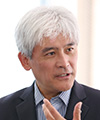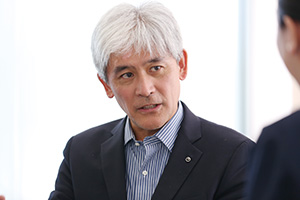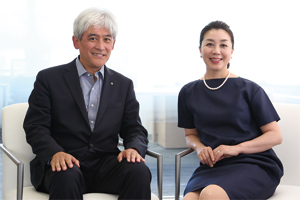 |
|
|
|
|
|
View from the Top Vol. 17, No. 11, pp. 1–5, Nov. 2019. https://doi.org/10.53829/ntr201911tp1
At the Epicenter of Innovation—How an Open Mind Fundamentally Changes How We Define “The Next Big Thing”OverviewNTT Research, Inc. was established in Palo Alto, California—in the heart of Silicon Valley, USA—in April 2019. It comprises three laboratories, 1) Quantum science and computing, 2) Medical and health informatics, and 3) Cryptography and information security. The goal is to build a new human-resource ecosystem in the areas of advanced basic research that can fundamentally change the way we live and the way we work. Keywords: NTT Research, Inc., research and development, digital twin computing A grand opening encouraged by both academia and business—First, congratulations on the success of the grand-opening reception. I felt the enthusiasm for your endeavor. I’d like to express my sincere appreciation to those guests who came to the opening event, including representatives from Stanford University and other leading institutes, as well as renowned business leaders—many of whom are NTT’s clients. This reception confirms my belief that NTT Research, Inc. will excite and inspire both academia and industry. At the event, I received wonderful feedback. Many guests expressed their appreciation for NTT’s long-term commitment to work that can fundamentally address various social problems. We’ll do this by empowering researchers and revitalizing their research, which is not necessarily an approach that many other companies would dare to take. I do not wish to be incautious, but there are clearly significant expectation and excitement surrounding our efforts. —Tell us about your management policy. Our core mission is to create intellectual properties related to novel technologies that will fundamentally change the way society works. I want to approach this by promoting a sort of “chemistry” between the existing NTT Group’s research and development (R&D) activities and the global talents here in the Silicon Valley. As a corporate research institute that conducts R&D using the funds allocated from each NTT Group operating company, NTT Research, Inc. should increase the value of NTT Group as a whole through basic and fundamental research activities. By sponsoring the world’s leading researchers and scientists, whose great vision and insights will deliver cutting-edge technologies and inventions, NTT Research, Inc. represents the depth of NTT Group’s commitment. Of course, the outcomes from those highly accomplished and motivated researchers are what will ultimately define our core values. —Why did you choose to be based in Palo Alto? Palo Alto, located in the heart of Silicon Valley, is the ideal location for NTT Group and NTT Research, Inc. Having Stanford University and an entire ecosystem for innovation, Palo Alto is the birthplace of innumerable new technologies. It’s a unique atmosphere that makes it easy for people to come together and develop new ideas. I feel that the “air” here is different. We have many potential collaborators and partners here who are the best researchers, scientists, engineers, and visionaries in the world—all within a business environment that supports their efforts. Having said that, it seems natural to expand our activities to a place like Silicon Valley.
Three research laboratories to strengthen our global business competitiveness—NTT Research, Inc. has three laboratories. Tell us what role each of them plays and what each one is developing. The Physics & Informatics Laboratories explores the interdisciplinary field between physics and informatics, in which NTT laboratories have accumulated our own technologies. At this laboratory, we conduct basic physics research, especially on quantum theories concerning dissipative systems, as well as research to establish completely new theories on applications of quantum theories to information processing. As for basic research on cryptography and information security to build a safe and secure future, the Cryptography & Information Security Laboratories studies cryptography for advanced functions and safety theories concerning scattered environments (such as those involving blockchain). In addition, the Medical & Health Informatics Laboratories are applying technologies such as artificial intelligence for analyzing biological information in a manner that leads to precision medicine. The directors of these three laboratories are world-renowned and proven experts. Indeed, we are leveraging their human networks to form new research teams for collaboration with NTT researchers in Japan. By adding other outstanding researchers around the world to the mix, we’ll empower the unique technologies accumulated by NTT laboratories. Recently, NTT R&D released a visionary theme called Innovative Optical and Wireless Network, or IOWN for short. IOWN is the overall concept of innovative optical-based networks and related technologies that NTT is currently investigating. One example of what is possible with IOWN is digital twin computing (DTC), which accurately reproduces the physical world in cyberspace. This permits various simulations and testing that make it possible to precisely predict the state of physical substances. For example, if you apply this concept in the medical field, DTC will allow us to predict the types of diseases that a particular individual may develop if they stay on the same diets, habits, sleep patterns, etc—all based on analysis of their digital twin. In other words, the precise information associated with a real individual will be used to model a duplicate of that individual in cyberspace. When such models are effectively created, they allow us to precisely prescribe the correct medical interventions for that individual. This approach is a bit like a human version of the weather forecast. Today, weather predictions have become more accurate, even to the point of knowing when rain will begin to fall—within a range of just minutes—in a particular geography. This precision is achieved by gathering information from a number of sensors at the national and global levels and utilizing massive computing power to analyze the information via sophisticated models. The digital twin metaphor I mentioned earlier is similar to modern weather forecasting. The only difference is that we apply this approach to human bodies. This will ultimately improve the health and life expectancy of all humankind. To achieve such a world, a huge amount of processing power is required. The issue of privacy must be seriously addressed along the way. Moreover, we need to figure out how to collect and accumulate medical information and how to model human bodies in the cyberspace. Apart from DTC and its application in the medical field, new types of cryptography are attracting attention. Today, encryption is used to prevent information theft or to prevent stolen information from being read (i.e., encryption). However, as we exchange more and more data throughout our daily lives, the meaning of encryption will change. Access to information may no longer revolve around a single “key.” Different kinds of keys may begin to allow targeted access to predefined portions of information—all based on the type of key provided. It will no longer be an “all or nothing” scenario in terms of accessing information. One can create special keys based on the profiles of different readers. This allows adjusted access per individual. Researchers at NTT Research, Inc. are currently at work on this type of encryption. As such technologies mature, I expect significant impact to our society. We foresee quantum computing, next-gen encryption technologies, and medical and health informatics as crucial to realizing DTC. Of course, these areas of focus—studied by our three laboratories—are challenging. Therefore, we are required to make long-term commitments before they yield meaningful outcome. Also, some hurdles may not be overcome just by applying the results of our own basic research. However, combining these three themes will surely get us closer to achieving the final goal of Bio DTC. The people who attended our opening event are excited about our work and stated direction, so I feel we are on the right track. —With such vison in mind, tell us what should we expect from R&D. My first assignment when joining NTT was R&D (voice recognition related technology development). However, I have been on the business side for the last 18 years. Rather than conducting or leading R&D activities, I was in a position to leverage the results coming from R&D within our business practices. The business-side expectations for technologies, products, and services coming out of R&D are vast. In other words, I recognize the results of our research as something that provides NTT with substantial advantage in the world of business competition. Also, the reputation of NTT as a company with unequaled research capabilities and long-term vision helps NTT sustain the trust and respect of our partners and customers. Today, information technology (IT) is probably the most important source of innovation for almost all companies, regardless of what market they play in. Missteps or ignorance on IT may, with high probability, create fatal issues for a company. For many corporate leaders, therefore, selecting the most trustworthy IT partner is not only critical but strategic. But what kind of partner is “trusted?” From a customer’s point of view, a trusted partner is a player you want to deal with for a long time, whose value grows rather than diminishes with each passing day. To that end, we need to be a company with a robust R&D team. We need to have vision and execution capabilities. I want NTT Research, Inc. to become a key propeller of the sense of trust NTT Group enjoys in the market. To gain and sustain that reputation, a solid vision with foresight—while broadening our field of view through outstanding researchers and R&D teams—is essential. As importantly, we must produce excellent results. Incidentally, when I was interviewed by magazines several years ago, I called myself a “technology geek.” Although I believe I still am, when I see presentations by the researchers at NTT Research, Inc. or I talk with them about their work, I feel they are a hundred times more enthusiastic than I have ever been. On one hand, I am thrilled that we are able to launch NTT Research, Inc. with such an exciting and talented group of people. On the other hand, I feel embarrassed a bit having called myself a technology geek (laugh).
Being open minded: start by accepting anything—You have faced competitors not only in Japan and the United States but also around the world. Are there any lessons learned from these previous experiences? We are living in an ever more globalized society. What I’ve been feeling while doing business in the United States is that many companies in this market are represented by people from many different nationalities and ethnic groups. I like soccer, so let’s take soccer as a metaphor. When playing against a team populated by the best players from many different nations, Japan’s national team, even if it represents the best players in all of Japan, may fall short of victory. I feel strongly that we have to form a team by selecting the best players from all over the world. Coaches or managers of such teams must know how to assemble these players, to inspire them and unify their focus. To win games, our managers must be prepared to analyze, judge, and lead, while remaining open-minded to the diverse perspectives and unique talents of every player. Needless to say, if you work based solely on a general idea of “common sense” for Japan, your teammate from a different background may not be as happy (or effective) using that approach as you are. In other words, because your teammate comes from a different culture with a different concept of common sense, your proposal, opinion, expression, etc., may not be taken as you might have intended. If you feel uncomfortable with your teammate or that something is strange, you should not be dismayed or defensive. Rather, take a deep breath and pause. Determine why what was said was said and find the real intention behind the words. Maintaining an open mind to differences is crucial to teamwork. Look for the potential and the positive in alternative points of view. I learned this lesson while working in the United States, where I’ve lived for a long time. There, society as a whole feels more open to differences, and those who are socially successful are usually most open-minded. I believe this is an insight we must value within any diverse culture. —What can we do to encourage researchers to develop this open-minded perspective? First of all, I recommend getting out of the laboratory in Japan. Go work with people of various cultures and backgrounds. Please seize any opportunity, especially as young researchers, to step outside of your box even for a short period of time. Outside of their labs, I’d like them to actively interact with people who make them a bit uncomfortable. At the same time, you have to be cautious. I myself haven’t succeeded in everything at every occasion. Rather, I’ve had bitter experiences that I don’t like to talk about even now. You should not follow other people blindly; trust your own instincts. This is especially true in the US business scene where contracts are crucial. We must represent our own perspectives with respect but also with strength—to strive for a sense of balance between trusting and doubting. Throughout my own experiences, setting goals for myself has helped me grow. Finding a mentor can be invaluable, someone who gives sensible advice from time to time. Ideally, a mentor should be readily accessible. However, even if your mentor is far away, it’s important to have someone you can model yourself after, someone who inspires you to become your best self. For me, former IBM chairman Louis V. Gerstner was such a role model. I still remember listening to his speech at Telecom 1999 in Switzerland. When I heard his speech, I said to myself, “I want to be able to deliver a message as strongly and convincingly as he does.” That was 20 years ago.
I want the world to say, “NTT Research, Inc. is amazing!”—Your speech at the opening event was very impressive. Thank you for saying so. As for my presentation, I tried to make a speech like Mr. Gerstner would have done. The presentation that inspired me back in 1999 was about the e-business that IBM was promoting at the time. He didn’t use any slides; instead, he went on stage and just talked without looking at any materials. Talking about e-business for almost an hour, he mesmerized everyone at the venue. At that time, I thought “This is cool; this is it!” That’s why at our opening event, I presented in the “Gerstner style.” —I felt that you had already established your “Kazu-style presentation.” Now, NTT Research, Inc., which was introduced in your Kazu-style presentation, is finally in full swing. How will you proceed from now onwards? Tell us your aspirations. “Kazu-style”? Thanks for the compliment! As of July 9, NTT Research, Inc. was officially launched with about 30 people. Among those members, approximately 20 are researchers, all of whom have doctorates. More than half are star players with the title of professors. While I use their titles, such as doctors and professors, as a means to describe the superiority of NTT Research, Inc. members, this is not just about titles. They all have outstanding talent and track records. I am glad that we are starting this new endeavor with these talented people. In a sense, I feel that I am very lucky. In return, though, to meet the expectations of these ambitious researchers, I’m determined to build NTT Research, Inc. with a clear vision in mind. Currently, we’re conducting research in the three areas I mentioned earlier from our base in Silicon Valley. However, it is necessary to expand our research focus and the footprint of our activities in the future. To that end, I will create an environment that permits researchers and other staff to work together comfortably and enthusiastically. I want to accelerate this important work and produce results so that the world will say “NTT Research, Inc. is amazing!” Interviewee profileCareer highlightsKazuhiro Gomi joined NTT in 1985. Before taking up his current post in April 2019, he served as Vice President (VP) of the Global Business Department of NTT Communications from 2001 to 2004, after which he served as VP of the Global IP Network Business Unit of NTT America (2004 to 2009), Chief Operating Officer of NTT America (2009 to 2010), and President and Chief Executive Officer of NTT America (2010 to 2019). |
|












